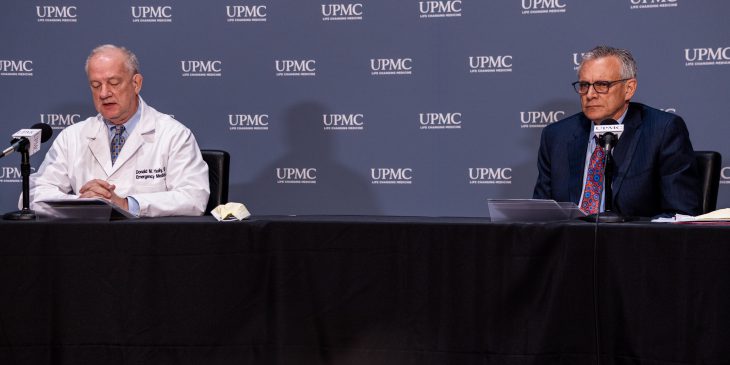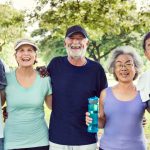Dr. Donald Yealy, chair of emergency medicine at UPMC, and Dr. Steven Shapiro, UPMC’s chief medical and scientific officer, testified before the Pennsylvania Senate Aging & Youth and Local Government Committees on May 13, 2020. Video of their testimony is below, and following are their remarks:
Dr. Yealy
Madame Chairs, Chairmen and Senators, thank you for the opportunity to present testimony before your committees today sharing the experience of UPMC’s and its findings related to the novel coronavirus, and that’s the agent responsible for COVID-19 illness and the pandemic. I currently serve as senior medical director at UPMC and chief of emergency medicine, so in other words, in my day job, I see people on their worst first day. I’m a lifelong resident of the Commonwealth of Pennsylvania.
When the regions throughout Pennsylvania saw their first COVID-19 cases two months ago, much was unknown about this virus. Since then, we have learned a lot about the virus, about how to care for people with COVID-19 illness and a lot about how the interventions to manage the virus effect not only care, but people. We now are in a very different place than where we started, and we can continue to learn and hone our actions based on all of those observations.
We started physical distancing and social isolation to “flatten the curve,” that is decrease the rapid growth, and the goal of that was to prevent our hospitals, emergency departments and intensive care units from becoming overwhelmed. The curve flattened because of all the activity and cooperation – there are now fewer new detected infections, fewer people hospitalized and fewer people dying.
But “flattening the curve” cannot get rid of infections it can’t even cut the total number of people who acquire the COVID-19 illness or infection. It simply spreads out cases over a longer time That allows us to learn and start other interventions.
While we work hard to create breakthroughs that create immunity through vaccines or antibodies, we expect that approximately the same number of people will eventually acquire the infection or become ill, whether or not we flatten the curve.
There are some recent observations that help inform us about the infection’s impact across our community and in special settings, and there are some intriguing insights:
- – The world watched as the Diamond Princess cruise ship, with many older passengers, became the largest COVID-19 cluster outside of China. Of over 3,700 people and passengers aboard the ship, 712 eventually tested positive for the virus, nearly half of whom had no symptoms. Ultimately 14 of these people sadly died, nearly all over age 70.
- – Let’s contrast that with another vessel. The USS Theodore Roosevelt was carrying nearly 5,000 sailors – these are mostly healthy younger people – when COVID-19 illness was detected on that ship. Approximately 1,000 sailors tested positive, with seven hospitalizations and there was one death.
Any death is a tragedy, these tell us an important lesson – the virus can infect many, but the poor outcomes are largely concentrated, not exclusively, but largely concentrated, in certain groups.
Our own hospital system, the communities we serve and Commonwealth observations all align with these examples. We now know who is most vulnerable to bad outcomes and death from COVID-19 illness and infection. Knowing this helps us take a more targeted approach to keeping as many people as safe as possible.
Worldwide, here in the Commonwealth, in western Pennsylvania, and in all of the communities, including central Pennsylvania, that UPMC serves, we know that the elderly are the most vulnerable people, especially those who reside in assisted living facilities or nursing homes. Two-thirds of our current COVID-19 admissions and nearly three-fourths of the people who die from COVID-19 infection come from that groups. In Pennsylvania, the median age of death from COVID-19 illness is 84 years old. Just to put that in reference, the average life expectancy in the Commonwealth is 78.5 years.
There are examples of success despite these concerns. UPMC provides secure and friendly surroundings to nearly 3,000 older adults in more than 30 UPMC Senior Communities throughout the regions we serve. Before a single case of COVID-19 hit our regions, we put into place plans and precautions to protect our elderly residents, and we’ve adjusted those plans and added to the precautions as we’ve learned more about the virus.
To date, there have been no COVID-19 positive cases at the UPMC Senior Community facilities. Tragically, other long-term care facilities have not had the same success that we’ve experienced. These residents often are sent to UPMC for care, and I’ve personally seen first hand, as well as my partners in the hospitals, how devastating this illness is to that population. The precautions we put in place early on are working. Opportunity still exists across all the areas we serve and across the Commonwealth, and we want to help.
The lessons learned in this is that proximity and density of people are important risk factors for infection, but harm happens mostly to vulnerable populations. For healthy people who work in all walks of life – from school teachers to sailors – having the virus usually yields no symptoms or feels like a normal cold or the flu with recovery.
COVID-19 illness ravages those who have preexisting conditions, especially the elderly. We can help deliver care, as not only health care providers but as a society, particularly as we reengage, if we focus on the vulnerable and particularly those with preexisting conditions and the elderly.
We can’t eradicate the virus quickly, but we can focus on isolating after identifying and addressing the conditions of the vulnerable people who are most vulnerable and at risk. If we focus on the elderly, we will bring a death rate that is approximately 1% right now down to fractions of a percent.
In sum, we know the elderly, sick and poor pay the heaviest price for COVID-19 illness and infection. We can guide the next steps in acclimatizing to a virus that will be here for months to years by protecting the most vulnerable, particularly the elderly. We know how to do that.
Dr. Shapiro
Madame Chairs, Chairman and Senators, I am also pleased to appear before your committees to discuss what we at UPMC know about the coronavirus based upon our clinical experience and research, which will help inform how to safely reopen the economy and society.
I am UPMC’s chief medical and scientific officer and president of UPMC’s Health Services Division, which consists of our 40 hospitals in Pennsylvania, Maryland and New York, comprises over 5,500 licensed beds, 700 doctors’ offices and outpatient sites and more than 6,300 employed and affiliated physicians.
In addition to what Dr. Yealy said in terms of our experience, around mid-April we peaked, and at that time we utilized about 2% of 5,500 beds and 48 of 750 ventilators, and since then, admissions have been decreasing with a majority them now coming from nursing homes. As we’ve started to reopen and get back some of our essential care, we have been testing on all preoperative patients, even those who are asymptomatic. Having done over 2,000 viral antigen tests on asymptomatic patients to date, we have four positives: three in central Pennsylvania and one in western Pennsylvania. Right now in our areas, the rate of community infection is extremely low.
This will help inform how we grapple with opening society. Philadelphia, not too dissimilar to New York, with high case rates as a result of density, travel and socioeconomic diversity, must open up in a measured, stepwise manner with extensive testing, contact tracing and treatment. But, for the rest of the state, as people come out of their homes cautiously and safely, if we protect our vulnerable seniors, particularly those in nursing homes, we should be able to keep case rates manageable, buying time to prepare for a potential resurgence as we bolster our supply chain and discover effective interventions.
COVID-19 is a disease that ravages those with preexisting conditions – whether it be immunosenescence of aging or the social determinants of health. We can manage society in the presence of this pathogen if we focus on these preexisting conditions.
What we cannot do is extend social isolation. Humans are social beings, and we are already seeing the adverse mental health consequences of loneliness, and that is before the much greater effects of economic devastation take hold on the human condition. The Academy of Family Medicine estimates up to an additional 154,037 deaths of despair from drugs, alcohol or suicide over the next decade attributable to the rise in unemployment, isolation and uncertainty.
This has been a wake-up call for our health care system and our nation in general. Health care workers have stepped up to the challenge, and we will be here to safely and scientifically help our society reemerge.
One thing is certain: Pandemics will be part of our future, and we must be better prepared. We can’t be put in a position to have to choose between death by pathogen or death by economic shutdown.
In this particular case, the problem we’re not going to be able to fix in the short term is the complete eradication of the virus. The problem we can fix is to serve and protect our seniors, especially those in nursing homes.
If we do that, we can reopen society, and though infectious cases may rise, as in the Theodore Roosevelt, the death rate will diminish, providing time for the development of treatments and vaccines.









